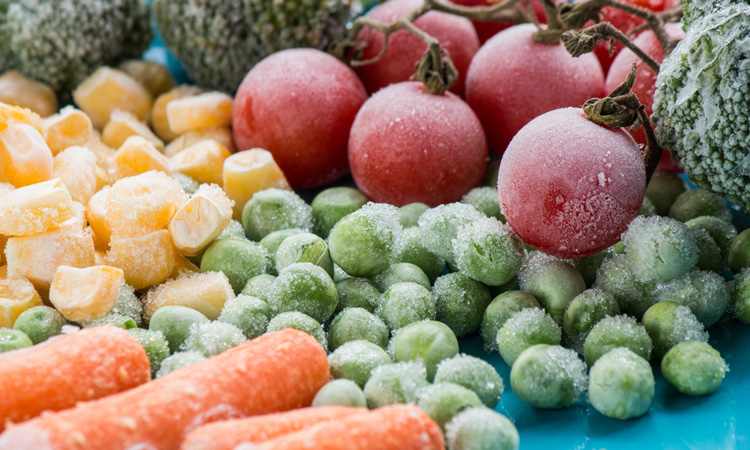The fight against Listeria in frozen food
- Like
- Digg
- Del
- Tumblr
- VKontakte
- Buffer
- Love This
- Odnoklassniki
- Meneame
- Blogger
- Amazon
- Yahoo Mail
- Gmail
- AOL
- Newsvine
- HackerNews
- Evernote
- MySpace
- Mail.ru
- Viadeo
- Line
- Comments
- Yummly
- SMS
- Viber
- Telegram
- Subscribe
- Skype
- Facebook Messenger
- Kakao
- LiveJournal
- Yammer
- Edgar
- Fintel
- Mix
- Instapaper
- Copy Link
Posted: 11 March 2020 | Sam Mehmet (New Food) | No comments yet
Frozen food manufactures are addressing some unique food safety challenges, which the American Frozen Food Safety Institute (AFFI) is actively championing through research, education and best practices. Dr Sanjay Gummalla, AFFI’s Senior Vice President of Scientific Affairs, tells New Food’s Sam Mehmet more.


For centuries, the act of freezing has allowed us to extend the life of fresh foods; frozen meals offer consumers convenience, taste, variety and nutrition and can be enjoyed by simply following cooking instructions that ensure safe consumption. According to the American Frozen Food Institute (AFFI), 99.4 percent of American households bought frozen food in 2018, and consumers of all demographics would have purchased this commodity at some point in their lives.
The frozen food companies that manufacture these products and enable consumers to avail frozen foods apply robust food safety programmes in their facilities, however, there remain food safety risks, which uniquely are dominated by the pathogenic bacterium, Listeria monocytogenes, Dr Sanjay Gummalla, Senior Vice President of Scientific, AFFI, told New Food.
What is AFFI?
The AFFI is a national trade association for the frozen food industry; representing a variety of frozen foods; vegetables, fruits, entrees, breakfast items, side dishes, and many emerging product innovations.
Domestic frozen food manufacturing is a strong sector, however the industry is also typified by a global supply chain. “We may have, for example, frozen vegetables coming in from different parts of the world to the United States, or for further processing. Many of the frozen products that are manufactured by our members are available in retail grocery stores for consumers to enjoy, but there is also a robust b2b market for frozen vegetables and fruits that cater to industrial and food service channels worldwide,” Dr Gummalla explained.
The threat of Listeria monocytogenes
Of course, all pathogens impact the food industry, but in the frozen space Listeria monocytogenes is considered a particular threat. The primary reason is that it is ubiquitous; it has the ability to find harbourage in facilities, especially where there are high moisture levels and cool environments. Some of these facilities can offer optimal environments for Listeria growth, Dr Gummalla noted. Furthermore, as more raw produce comes from fields to facilities, there is a risk for repeated entry of Listeria, and this pathogen has the potential to further spread across the production environment through movement of personnel and vehicular traffic.
This transfer of pathogens can occur if appropriate safeguards are not taken by the facility, and their omnipresence means there is potential not only for harbourage of Listeria in the facility but also for cross contamination of foods. Historically, Listeria monocytogenes has been associated with soft cheeses and deli meat, but more recently this list has expanded to broader categories of foods.
If we do the right things in manufacturing, the opportunity for Listeria monocytogenes to contaminate a food at the end of the supply chain is minimised.
Frozen is considered a state where foods do not support the growth of Listeria monocytogenes, but severe outbreaks – some of which have even led to deaths – have elevated awareness of the dangers, which is where AFFI takes its place in the frozen food supply chain.
One of the key challenges with Listeria monocytogenes is the fact that, despite the relatively low rates of listeriosis (the disease caused by the consumption of food contaminated with Listeria monocytogenes) the mortality rate is around 15 percent and kills approximately 250 people each year in the US1, primarily impacting susceptible populations such as the elderly, infants, pregnant women and immunocompromised individuals. In comparison, the US Center for Disease Control and Prevention (CDC) estimates that Salmonella causes over a million illnesses each year, but the mortality rate is much lower. It nevertheless also results in over 400 deaths each year, according to Dr Gummalla.


Listeria monocytogenes is an organism which can cause serious and sometimes fatal infections in young children, frail or elderly people, and others with weakened immune systems.
Although the dangers of Listeria monocytogenes are still prevalent, and some will argue that cases of related product recalls are rising, Dr Gummalla said that “we have made strides in the United States, and even globally, in our ability to address Listeria monocytogenes.” He attributes this to collaboration between industry, academia and government, who have worked together to advance and apply science-based approaches.
“Food manufacturers continue to place efforts to prevent and limit Listeria monocytogenes’ omnipresence and ability to find harbourage in food facilities – through improved sanitation practices, environmental monitoring programmes and investments in hygienically designed equipment and facility infrastructure. Listeria monocytogenes can be inactivated by heat used in thermal food processing of foods, however, many products, such as ready-to-eat deli meats and soft cheeses, lack these processing steps and rely on their sanitation controls and good manufacturing practices to lay the foundation of food safety assurance in such food products.”
Kill steps
At the facility-level, kill steps – or lethality steps – provide a valuable means to attain effectively reduce the presence of Listeria monocytogenes, but these processes must be validated, Dr Gummalla explained.
“AFFI embarked on a process to develop methodologies that assist companies validate their kill steps in frozen vegetables,” he said. “Blanching is one part of the process of manufacturing frozen vegetables. It was originally intended to be a way to arrest enzyme activity and improve the quality of the raw materials prior to freezing, but appropriate time and temperature treatment can also serve as an effective heat step. AFFI’s research established correlation of key time and temperature parameters with significant log reduction of Listeria monocytogenes.”
The AFFI has developed a number of resources to help companies assess their food safety practices, with questions such as ‘What are your sanitation practices?’ and ‘How do you manage environmental monitoring of your facilities?’
Food manufacturers continue to place efforts to prevent and limit Listeria monocytogenes’ omnipresence and ability to find harbourage in food facilities…
“We have brought about 80 food safety professionals from the frozen food industry together as a food safety working group to discuss and develop these best practices, which resulted in the publication of AFFI’s Listeria Control Program hosted on our online food safety resource portal – AFFI Food Safety Zone.
“We endeavour to make food safety a non-competitive element of the frozen food industry. While it is very targeted to frozen, it is obviously a challenge for every industry and so anyone can use AFFI’s resources,” Dr Gummalla said.
The Listeria Control Program is comprised of best practices in seven important categories. In each of those categories, AFFI provides multiple recommendations, which were developed by the working group of professionals. “There are more than 120 brief recommendations in all and in each of these, we developed individual documents; one or two page resources that help the companies to implement them.”
The AFFI has also put together resources for the fight against other food safety risks to frozen food, such as norovirus and hepatitis A. “While they do not grow in foods like pathogenic bacteria such as Salmonella and Listeria, these viruses present public health risks.. For this reason, it is another important set of resources – and we are continuing to build on them,” Dr Gummalla said.
The AFFI is also supporting the development of innovative technologies to help in the fight against Listeria monocytogenes, Dr Gummalla told New Food. “I lead the scientific affairs group and am currently collaborating with several companies that bring novel technologies to complement frozen food manufacturers’ food safety efforts.
He emphasised the need for new technology to truly make a difference when it comes to the fight against pathogens, urging others to evaluate and potentially use these novel methods.
Zero tolerance
Another challenge the industry is facing in the US is the nation’s zero tolerance regulatory approach. Any positive finding of Listeria monocytogenes is considered an adulterant. Although this is positive from a regulatory standpoint, he explained that when you have a zero tolerance approach, industry is sometimes less enthusiastic about actively going and looking for it.
“If we do the right things in manufacturing, the opportunity for Listeria monocytogenes to contaminate a food at the end of the supply chain is minimised. We believe efforts must be placed on facility sanitation and environmental monitoring, rather than rely solely on finished product testing. Remember you cannot sample every batch, only a small portion, so there is a lot of work yet to be done on sampling and testing,” he said.
The other step is to educate and inform stakeholders that may have access to these susceptible populations.
AFFI has invested in gaining more information and a better understanding of the prevalence of Listeria frozen food facilities. “Our global expert panel is reviewing this research and other current Listeria science in an effort to develop some new approaches to address these issues and helpregulatory agencies. These new approaches, while aimed at progress on eliminating contamination in food, are also committed to achieving the public health goals that these regulatory agencies are striving towards.” By Comparison, in Europe there is a tolerance level of 100 CFU (colony forming units per gram of the food) for certain foods.2 “Here facilities are able to test and get an understanding of what the prevalence is and if their best practices are effective,” Dr Gummalla commented.
Consumer Education
Consumer behaviours and the application of cooking instructions provided on food packaging play a critical role in ensuring safe consumption of frozen foods. “The other step is to educate and inform stakeholders that may have access to these susceptible populations. This is an area that we have just begun to try to tackle ourselves,” Dr Gummalla said. This education includes information about how to improve packaging, cooking food at the consumer level, and ensuring that the susceptible populations are particularly aware of the steps to ensure safe consumption.
“There’s still a lot of work that needs to be done. Industry has made some big strides in terms of tackling Listeria in the broader food industry, and this is reflective in the lowered rates of Listeriosis incidence particularly between the years of 2000-2010, but that progress has since plateaued. The industry is committed make greater progress; nevertheless, I am really proud of what the AFFI has been able to accomplish so far and I am certain we will continue to find solutions to evolving frozen food safety challenges.”
References
- https://www.cdc.gov/listeria/technical.html
- https://efsa.onlinelibrary.wiley.com/doi/10.2903/j.efsa.2018.5134
Biography


Prior to joining AFFI, Sanjay was the Vice President of product development at Zentis NA, a global fruit preparation manufacturer. His technical expertise extends to flavour development, food microbiology, and product development resulting from managing global food application projects at Givaudan Flavors and leading the global dairy flavour research and development portfolio at Cargill.
He was a post-doctoral researcher at the US Food and Drug Administration (FDA) representing FDA’s foray in to nanotechnological applications for food safety. He holds a Ph.D. in Nutrition and Food Sciences from Utah State University.
Related topics
Contaminants, Food Safety, Frozen Foods, Health & Nutrition, Pathogens, Refrigeration and freezing, Regulation & Legislation, Supply chain, The consumer







